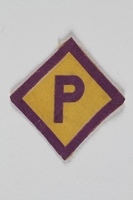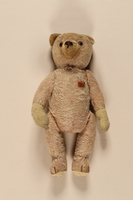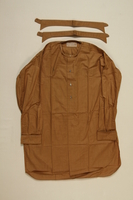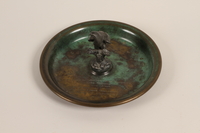Overview
- Brief Narrative
- Ivory cuff bracelet presented to an SS member, engraved with swastikas and Munich, Germany, 1933. The SS (Schutzstaffel; Protection Squadrons), commanded by Heinrich Himmler from 1929, considered itself an elite corps of the Nazi Party based on race-nationalist visions of racial purity. In 1936, the SS established the Lebensborn (Fount of Life) program that decreed that every SS man should father four children, in or out of wedlock. Lebensborn homes were created to house and care for the illegimate children and their mothers.
- Date
-
commemoration:
1933
- Geography
-
creation:
Munich (Germany)
- Credit Line
- United States Holocaust Memorial Museum Collection
Physical Details
- Language
- German
- Classification
-
Jewelry
- Category
-
Bracelets
- Object Type
-
Cuff bracelets (lcsh)
- Physical Description
- Elephant ivory bracelet with a polished smooth exterior with raised narrow bands around the top and bottom edge. The wide, central band is carved with alternating Nazi insignia: 4 swastikas and 4 SS lightning bolts, painted gold. The interior is slightly rough and has darkened to a golden brown. It is carved with a year and city name. A small, circular hole is pierced through one side.
- Dimensions
- overall: Height: 2.875 inches (7.303 cm) | Width: 2.625 inches (6.668 cm) | Depth: 1.250 inches (3.175 cm)
- Materials
- overall : ivory, paint
- Inscription
- interior, carved : MÜNCHEN 1933
Rights & Restrictions
- Conditions on Access
- No restrictions on access
- Conditions on Use
- No restrictions on use
Keywords & Subjects
- Geographic Name
- Germany--Politics and government--1933-1945.
Administrative Notes
- Legal Status
- Permanent Collection
- Provenance
- The bracelet was acquired by the United States Holocaust Memorial Museum in 2001.
- Record last modified:
- 2023-08-25 12:29:55
- This page:
- https://collections.ushmm.org/search/catalog/irn509410
Download & Licensing
In-Person Research
- By Appointment
- Request 21 Days in Advance of Visit
- Plan a Research Visit
- Request to See This Object
Contact Us
Also in Lebensborn collection
The collection consists of artifacts, books, pamphlets, and photographs relating to the Lebensborn program in Nazi Germany which encouraged the birth rate among persons designated as racially pure Germans.
Date: 1935-1943

Forced labor badge, yellow with a purple P, to identify a Polish forced laborer
Object
Forced labor badge, yellow with a purple P and a purple border, that would be worn to identify a Polish forced laborer in Nazi Germany. German regulations required the workers to wear the badge with the purple band visible around the P on the right chest to keep them separate from the German populace. During the German occupation of Poland, 1939-1945, many non-Jewish Polish people were sent to Germany as conscript labor for civilian labor details on farms and factories. Workers sometimes volunteered for the forced labor service, but the majority were forcibly recruited and conditions worsened as the war continued. The German work force was depleted by the war and unpaid foreign workers were needed to keep the economy functioning.

Teddy bear used in an SS Lebensborn home
Object
Teddy bear used in an SS Lebensborn home. The SS (Schutzstaffel; Protection Squadrons), commanded by Heinrich Himmler from 1929, saw itself as an elite corps of the Nazi Party based on race-nationalist visions of racial purity. In 1936, the SS established the Lebensborn (Fount of Life) program that decreed that every SS man should father four children, in or out of wedlock. Lebensborn homes were created to house and care for the illegimate children and their mothers.

SA (Sturmabteilungen/ Storm Division) brown uniform shirt with 2 detachable collars
Object
Brown uniform shirt with two collars worn by members of the SA [Sturmabteilung/ Stormtroopers]. This Nazi Party paramilitary organization, also called Brownshirts to echo Mussolini's Blackshirts, was founded by Hitler in 1920, and led by Ernst Rohm. The Stormtroopers were known for their brutality and violence and were potent instruments of street terror during Hitler's rise to power. By the early 1930s, SA membership reached three million, and outnumbered the German Army. After Hitler became Chancellor in 1933, the SA's demands for political power and the placement of fanatical Nazis in all key positions threatened Hitler's plans for German expansion and he turned against them. Between June 30 and July 2, 1934, the Nazi Party leadership, on Hitler's order, purged the SA leadership to end the embarrassing conduct and political intrigues. The SA would remain a popular and murderous wing of the Nazi Party, but it would no longer be an independent political force.

Metal dish inscribed for a matron of an SS Lebensborn
Object
Commemorative dish inscribed for presentation to Erika Wittmann, the head of an SS Lebensborn called Sunny Meadows, in April 1943. The SS (Schutzstaffel; Protection Squadrons), commanded by Heinrich Himmler from 1929, saw itself as an elite corps of the Nazi Party based on race-nationalist visions of racial purity. In 1936, the SS established the Lebensborn (Fount of Life) program that decreed that every SS man should father four children, in or out of wedlock. Lebensborn homes were created to house and care for the illegitimate children and their mothers.
Lebensborn papers
Document
The papers consist of books, pamphlets, photographs, and other documents relating to the Lebensborn program in Nazi Germany which encouraged the birth rate among "racially pure" Germans.



